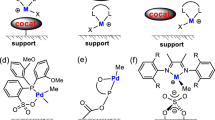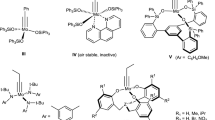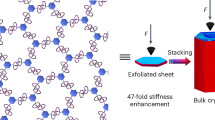Abstract
In the presence of the polyoxetane resin, R-1b, containing tri(oxyethylene) segments in the pendant chains, 1-bromooctane was converted to 1-iodooctane in 88% yield using solid NaI in hexane at 60°C, but 1-iodooctane was formed in a very low yield with solid KI in place of solid NaI, suggesting that the pendant tri(oxyethylene) segments of polyoxetane matrices caught sodium cations of NaI, but not potassium cations of KI, in the manner of cooperative coordination under anhydrous conditions. Although the corresponding di(oxyethylene) analogs hardly had such catalytic effect under the same conditions, when a polyoxetane resin anchored the pendant quaternary ammonium salts besides the pendant di(oxyethylene)s the yield of 1-iodooctane was remarkably improved. Under aqueous conditions using 60 wt% aqueous KOH and hexane, a polyoxetane resin anchoring both the pendant tri(oxyethylene) and primary alcohol moieties in an 1:1 mole ratio for OCH2CH2 and OH groups gave styrene quantitatively at 70°C from 2-iodoethylbenzene and in 92% yield from 2-bromoethylbenzene (12a) by adding NaI. Under the same conditions using NaI as additive, a polyoxetane resin having only the same hydroxy groups in the pendant chains also gave styrene in 51% yield from 12a, while R-1b, used in the above-mentioned halogen-exchange reaction, only gave a 9% yield of styrene. Thus, when used together with the pendant hydroxy groups, pendant tri(oxyethylene) segments act even under aqueous conditions as effective cosolvent species to carry NaI and KOH molecules into an organic layer.
Similar content being viewed by others
Login or create a free account to read this content
Gain free access to this article, as well as selected content from this journal and more on nature.com
or
References
M. Motoi, K. Shimamura, C. Shimamura, S. Muramoto, S. Kanoh, and H. Suda, Bull. Chem. Sci. Jpn., 62, 2553 (1989).
H.-Y. Xu, H. Ogawa, S. Kanoh, and M. Motoi, Polym. J., 31, 143 (1999).
M. Motoi, K. Noguchi, A. Arano, S. Kanoh, and A. Ueyama, Bull. Chem. Sci. Jpn., 66, 1778 (1993).
H. Ogawa, T. Hosomi, T. Kosaka, S. Kanoh, A. Ueyama, and M. Motoi, Bull. Chem. Sci. Jpn., 70, 175 (1997).
J. B. Rose, J. Chem. Soc., 546 (1956).
Y. Kimura and S. L. Regen, J. Org. Chem., 48, 195 (1983).
U. Heimann and F. Vogtle, Angew. Chem. Int. Ed., 17, 197 (1978).
W. M. MacKenzie and D. C. Sherrington, Polymer, 21, 791 (1980).
A. Hirao, S. Nakahama, M. Takahashi, and N. Yamazaki, Makromol. Chem., 179, 915 (1978).
A. Hirao, S. Nakahama, M. Takahashi, and N. Yamazaki, Makromol. Chem., 179, 1735 (1978).
E. Santaniello, A. Manzocchi, and P. Sozzani, Tetrahedron Lett., 47, 4581 (1979).
S. L. Regen and L. Dilak, J. Am. Chem. Soc., 99, 623 (1977).
W. M. MacKenzie and D. C. Sherrington, J. Chem. Soc. Chem. Commun., 541 (1978).
S. Yanagida, K. Takahashi, and M. Okahara, J. Org. Chem., 44, 1099 (1979).
J. G. Haffernan, W. M. MacKenzie, and D. C. Sherrington, J. Chem. Soc., Perkin Trans. 2, 514 (1981).
Y. Kimura, P. Kirszensztejn, and S. L. Regen, J. Org. Chem., 48, 385 (1983).
M. Motoi, H. Suda, K. Shimamura, S. Nagahara, M. Takei, and S. Kanoh, Bull. Chem. Sci. Jpn., 61, 1653 (1988).
R. Matsuura in “Gendai Mukikagaku Koza,” Gihodo Co. Ltd., Tokyo, 1971, vol. 7, p 126.
M. Motoi, H. Suda, S. Nagahara, M. Yokoyama, E. Saito, O. Nishimura, S. Kanoh, and H. Suda, Bull. Chem. Sci. Jpn., 62, 1572 (1989).
Author information
Authors and Affiliations
Rights and permissions
About this article
Cite this article
Ueyama, A., Mizuno, M., Ogawa, H. et al. Preparation of Polyoxetane Resins Anchoring Pendant Oligo(oxyethylene) Chains and Uses as Polymer Solvents for Alkali Metal Ions. Polym J 33, 754–764 (2001). https://doi.org/10.1295/polymj.33.754
Issue date:
DOI: https://doi.org/10.1295/polymj.33.754



